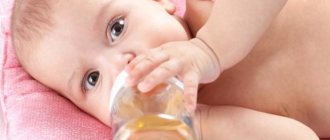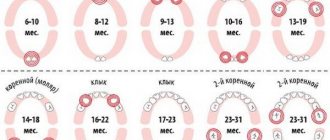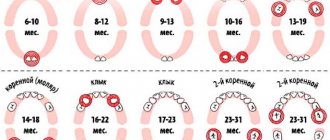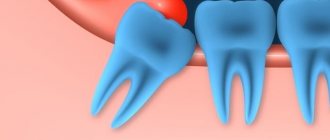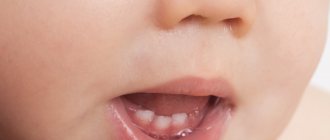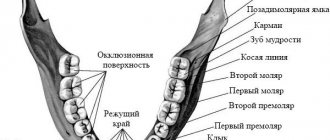Teething order
Is your baby about to turn 6 months old and are you noticing some anxiety in his behavior? This is natural, because the time of teething comes. And this is a difficult period in a child’s life.
The timing of teething in children can vary widely. Normally, the first teeth begin to appear closer to 6 months.
But it happens that baby teeth erupt earlier or much later. And there is nothing terrible here; this process is associated with the constitutional characteristics of the child.
- If you follow the pattern of teething in children, the central incisors on the lower jaw appear first. This usually occurs at 6-10 months.
- The upper central incisors appear at 8-12 months, and the first molars at 13-19 months.
- The canines “wake up” last – by 16-22 months.
- By the age of 2, a child usually already has 20 teeth, and from 6 to 12 years, baby teeth are gradually replaced by permanent teeth.
- Wisdom teeth do not have a milky version and appear in late adolescence.
Contrary to popular belief, the main dental problems in children are not related to the teeth, but to the gums. It is not surprising, because a child’s temporary baby teeth completely change over the years, but the gums remain with the person forever. One of the most common gum diseases is gingivitis - inflammatory damage to the mucous membranes of the gums.
The damage and changes in oral tissues caused by gingivitis are not irreversible. The main thing for the child’s parents is to identify the presence of a problem in a timely manner and in no case allow the course of the disease to take its course, or miss the time to start treatment.
A distinctive feature of gingivitis is that inflammation in this disease does not affect the tissue of the tooth itself, the periosteum, or the connection between the gum and tooth.
Causes
The main cause of childhood gingivitis is almost always an insufficient level of hygiene and prevention of oral diseases.
The main cause of gingivitis in children is insufficient attention to oral hygiene.
Parents often make the mistake of teaching young children to brush their teeth, but not supervising this process in the future. A child, not understanding the importance of oral hygiene, can turn the process of brushing teeth into a fun but useless game. The result in the form of plaque is usually visible, or rather, on the teeth and gums.
Plaque on children's teeth serves as an excellent food source for microorganisms, including pathogens. As the colony of microbes grows, it causes a response from the body—inflammation occurs.
Inflammation is a visible manifestation of the body's protective immune mechanisms in response to the harmful effects of environmental factors.
Although inflammation is a natural reaction of the body struggling with an undesirable effect, this fight does not pass without a trace - the body consumes internal resources, as a result of which the inflamed tissue is gradually destroyed.
The following factors also contribute to gingivitis in children:
- unbalanced diet, lack of important minerals and vitamins, especially vitamin C;
- injuries to the mucous membrane of the gums due to malocclusion, chewing hard food, burns from hot food or drink;
- viral infections;
- diabetes;
- hereditary predisposition.
Peculiarities
Gingivitis is extremely common in childhood and adolescence, as children are most susceptible to gingivitis. This is due to the increased susceptibility of periodontal disease in children.
The periodontium is a “structure” of various tissues that holds the tooth and also supplies it with necessary substances through an extensive network of blood vessels.
The incidence of gingivitis reaches its peak with the onset of middle school age, when the accelerated growth of periodontal tissue is superimposed on the “hormonal explosion” characteristic of adolescents.
Gingivitis is not uncommon in very young children, 1 year of age or younger. This is understandable, because one of the main factors in the occurrence of gingivitis is gum trauma, which is what happens during teething. And to these natural injuries is added the underdevelopment of the immune system and the weak saturation of the oral cavity of a small child with beneficial microflora.
Sometimes you can find gingivitis even in infants. Parents are advised to immediately contact a pediatric dentist if they detect any suspicious symptoms at such a tender age.
An additional risk factor may be a short frenulum of the lip, which interferes with proper gum hygiene and contributes to the accumulation of food debris. In most cases, the labial frenulum stretches on its own, but if this does not happen before the child is 2 years old, surgical resection is performed as prescribed by the doctor.
Symptoms and classification
In order to prevent the disease from developing and begin treatment as soon as possible, you need to correctly and timely recognize the symptoms of the disease. The symptoms of gingivitis directly depend on the stage in which the disease is located.
- Catarrhal is the mildest and most common type of disease. This acute stage is characterized by redness and swelling of the gum edges, itching, burning, and the formation of characteristic dental deposits. An unpleasant odor from the mouth is noticeable. An older child may complain of an unpleasant taste in the mouth. The famous pediatrician Evgeniy Komarovsky claims that catarrhal gingivitis and stomatitis in children often accompany diseases caused by herpetic and viral infections.
- Simple marginal is a chronic, sluggish type of catarrhal gingivitis. The symptoms are similar, but less pronounced. Noticeable pain with this variety is rare, and the itching can be quite severe, which is why this disease often goes unnoticed in young children - it is simply confused with natural itching during teething.
- Desquamative is manifested by profuse redness and peeling of the gum mucosa.
- Hyperplastic most often occurs with hormonal origins of the disease, which is typical for adolescents. This type of disease is distinguished by noticeable inflammation of the protrusions of the gums between the teeth - the so-called periodontal papillae. When swollen, the papillae form sinuses at the base of the tooth, which are often filled with foul-smelling pus. The gums bleed.
- Hypertrophic is a severe chronic form of hyperplastic gingivitis. The swelling of the inflamed periodontal papillae in this form of the disease is so pronounced that the crown of the tooth can be significantly (sometimes completely) hidden in the swollen gum.
- Ulcerative necrotic is a severe form of the disease. The child experiences severe burning pain, open bleeding ulcers form at the base of the teeth, and the bases of the teeth are partially exposed. Signs of general malaise may appear - weakness, nausea, fever.
- Atrophic - the most severe stage of inflammation of the mucous membrane of the gums, the gum tissue becomes noticeably thinner, and the bases of the teeth are greatly exposed. Bleeding and discharge of pus are profuse, severe pain requires medication relief.
If left untreated, childhood gingivitis progresses to the stage of deep periodontal damage - periodontal disease, which is fraught with the loss of a significant part of the dentition.
Treatment of gingivitis in children
Treatment in the early stages
Gingivitis in the early, not advanced stages (catarrhal and simple marginal gingivitis) can be easily treated on your own at home.
You should start by alleviating the child’s condition. Anesthetics, in particular various lidocaine-based drugs, will help relieve pain. For the treatment of children, it is recommended to use the lidocaine-containing drug “Kalgel”. This gel-like product is approved for use even for the youngest patients, even with gingivitis in a one-year-old child. "Kalgel" can be used, among other things, for teething in infants.
The use of bactericidal ointments and rinses, such as:
- Propsol;
- Eludril;
- Chlorhexidine;
- Romazulan.
Also, one of the most commonly used medications for gingivitis in a child is Cholisal gel. This drug, in addition to being anti-inflammatory, also has a bactericidal effect. In any case, before using vitamin supplements and medications, especially when treating gingivitis in infants, it is better to consult with your doctor.
It is also important to pay attention to the nutrition of children: food for gingivitis should not be too cold or hot, sour or salty. The main task during this period is to minimize the impact of irritating factors on the oral cavity.
After relieving inflammation and reducing pain, therapy is carried out aimed at destroying pathogens. For this purpose, antibiotic drugs are widely used, for example, Amoxicillin, Metronidzole, Erythromycin.
After the use of antibiotic drugs, restorative therapy necessarily includes a course of probiotic drugs that help restore the normal bacterial background and replenish beneficial microflora.
Treatment of hyperplastic and hypertrophic forms
Severe forms of gingivitis can only be treated in specialized medical institutions. Treatment of hyperplastic gingivitis and its severe form, hypertrophic gingivitis, in addition to an anti-inflammatory course and antibacterial measures, may include removal of swollen gum tissue. The following methods are used for this:
- Freezing . Sclerosing agents are injected into the gum tissue: dextrose solution or calcium chloride. The introduction of these drugs causes hardening of the periodontal papillae and the cessation of pathological tissue growth.
- Cauterization with electric current . It allows you not only to stop the growth of edema in a large area of tissue, but also to stop bleeding. Cauterization is carried out using the method of diathermocoagulation - exposing the tissue to a current of 3-5 Amps of high frequency. The procedure is painful and is performed under local anesthesia, so it is not recommended for children under five years of age.
- Chemical cauterization . A mixture of sulfuric acid solution and ether is applied to the dried surface of the gum with a cotton swab.
- Gum trimming (gingivectomy). It is used in especially severe cases, when healing a child’s oral cavity without surgery is no longer possible. The operation is performed under general anesthesia and, as a rule, occurs without complications. Gingivectomy must be combined with freezing or cauterization of the gums, otherwise the pathological growth may continue, and after some time the truncation will have to be performed again.
Treatment of ulcerative necrotic and atrophic gingivitis
The sooner a child suffering from ulcerative or atrophic gingivitis gets to a dentist, the better. At home, the child should be given bed rest and rest, as general malaise may be observed, accompanied by an increase in temperature.
In case of pronounced bleeding of the gums, when gingivitis has reached the ulcerative or atrophic stage, it is not recommended to use toothbrushes with hard bristles. In severe cases, you will have to refrain from brushing your teeth altogether, limiting yourself to rinsing your teeth with special balms.
Antiviral and anti-inflammatory therapy for these forms is similar to similar procedures for marginal and catarrhal gingivitis. Bleeding is stopped with the help of spot application (application) of hydrogen peroxide.
Necrotic (dead) tissue areas around ulcers are removed surgically or conservatively using the method of necrolysis - non-surgical resorption. Necrolysis of dead tissue is carried out by applying the sublimated enzyme trypsin dissolved in sodium chloride to the affected areas.
After the inflammation has stopped and the ulcers have healed, the child may need gingivoplasty - restoration of lost areas of gum by transferring tissue flaps from other areas of the periodontium.
Folk remedies
A serious help in the treatment of gingivitis will be turning to traditional medicine and homeopathy. To prevent oral diseases and strengthen teeth, decoctions of oak bark, sage, St. John's wort, and motherwort have long been used.
To treat inflammatory processes in a child, the use of alcohol-based infusions, as well as an alcohol solution of iodine, is not allowed!
Traditional recipes:
- St. John's wort oil. The product is prepared independently from dry leaves of St. John's wort, which can be purchased at the pharmacy. A tablespoon of crushed leaves is poured with half a glass of refined vegetable oil and left to infuse overnight. Lubricate inflamed gums with St. John's wort oil three times a day.
- A mixture of sage and eucalyptus leaves in equal proportions is poured with boiling water at the rate of a teaspoon of sage and eucalyptus per glass of boiling water. Leave for 24 hours and strain. Take a tablespoon before meals.
- Dilute 3-4 grams of mumiyo in a glass of warm water and use it to rinse your mouth before bed.
- Another way to use mumiyo: dilute the same amount (3-4 grams) in a glass of warm low-fat kefir (mix thoroughly!). Keep in mouth for two to three minutes, then swallow.
Prevention
The main means of preventing gingivitis, as well as other dental diseases, is oral hygiene. From a very early age, teach your child to brush their teeth for at least 10-15 minutes, making sure to pay attention to the inside of the teeth. Buy your child a therapeutic toothpaste and make sure he brushes his teeth correctly. To eliminate stubborn plaque, you can use a brush with moderately hard bristles. After brushing, teeth should be rinsed thoroughly.
Teach your child to use dental floss to remove food debris from between the teeth. But keep in mind that dental floss can also injure the gums if used incorrectly, so it is not recommended to use dental floss for a child under 3 years of age.
Modern dentistry does not encourage the use of toothpicks for dental care, since their use risks not only injuring the gums, but also causing infection. Give preference to dental floss.
If tartar has formed in your child’s mouth, then a visit to the dentist is essential. The doctor will remove tartar in the most gentle way possible.
Teeth from birth? It happens
In exceptional cases, children are born with teeth. As a rule, we are talking about the lower incisors. They are called (neo)natal teeth. They erupt within 30 days. Their root is mobile, not formed, and often such teeth quickly fall out.
This feature is fixed genetically - as a rule, the parents had the same thing, a characteristic picture is observed in the baby’s brothers and sisters. Doctors suggest removing such teeth to prevent them from entering the respiratory tract. But this is not a mandatory procedure, at the discretion of the parents.
Tips for parents
The period of teething is stressful, first of all, for the baby himself; he can turn from a calm, sweet child for some time into an uncontrollable, capricious, always crying one. All this is temporary, and the more parents pay attention and care to him, the calmer they react to all negative manifestations of behavior, the easier it will be for everyone to get through this difficult time. It is important to try to distract the child from unpleasant sensations with some kind of entertainment: games and toys, household items, songs, cartoons, fairy tales.
At this time, it is important not to go to great lengths in the form of trying out various medications just to calm the child down. In case of doubt, it is better to consult a doctor once again, but you should not engage in amateur activities. The same applies to the opposite situation, when even if prescribed by a doctor, parents avoid medications in every possible way, explaining that everything should proceed naturally without outside interference. If the child is really unwell, you should not refuse “helpers”.
It happens that during this period children refuse to eat - it is possible that this is due to discomfort in the mouth due to contact of aching gums with food. In this case, you can try cooling the food a little. Perhaps it is worth offering your child some natural edible teethers, dryers, for example, more often. But you still can’t do without purchased ones; it is advisable to have at least 2, one of which can have a cooling effect (you just need to monitor its integrity).
Teething symptoms
The appearance of teeth causes some discomfort in children, which affects their behavior and general condition. In the support chat for the online course “For Every Mom,” we will look in more detail at the main symptoms and means of helping the child and mother. May this period pass as calmly as possible for you.
Teething has accompanying symptoms that will help you understand the cause of these changes:
- Salivation
- Irritation and rash around the mouth
- Change in stool (usually loosening)
- Runny nose
- Temperature increase
- Anxiety
- Moodiness
- Sleep disturbance
This process is not fast. Discomfort may occur several days before gum eruption. If this stage is delayed, they speak of difficult eruption.
There is no reliable information about why the temperature rises during teething in children. It can be assumed that this is a preventive protective reaction of the body. After all, as a result of teething, a tooth creates a wound in the gum, and the body proactively turns on a protective mechanism in the form of inflammation and an increase in temperature. This is necessary to prevent infection of the wound surface...
Homeopathic remedies
The choice of homeopathic remedies for teething is generally small, and in this case only a few are widely used:
- Dentinorm Baby drops are a multicomponent drug that helps relieve discomfort in a child. Manufacturers have selected the most convenient form of release - the product is in containers with a single dosage. You can use it up to 3 times a day, but, as a rule, the effect of 1 bottle is enough for the whole day. Usually kids like the taste of this product. There are no age restrictions. The effect after taking the drug occurs after about 20 minutes;
- Traumeel ointment is one of the most popular products that has an anti-inflammatory and analgesic effect;
- Viburkol candles. They are used, of course, not only for teething. The drug is a good assistant in the treatment of many infectious diseases. In the case of babies, rectal suppositories are undoubtedly the most convenient means to use. “Viburkol” is used for weakness, elevated temperature, in order to mobilize a person’s internal strength to fight the disease. This antispasmodic has a sedative, analgesic, and anti-inflammatory effect. In addition, it is considered such a safe drug that it is prescribed even to newborn babies. For children under 6 months, use 1 candle 2 times a day. For very young children, perhaps half a suppository will be enough; to do this, you need to cut the candle in half lengthwise and, after warming it up a little in your hands, smooth out the sharp corners. Older children – also 1 piece, but 4-6 times a day;
- Dentinox is a gel that also helps with teething due to its analgesic properties. Apply to inflamed gums using rubbing movements;
- "Dentokind" is a homeopathic medicine in the form of lozenges. The product contains active ingredients that eliminate pain when teething. This home remedy reduces swelling of the gums, lowers the temperature, and also helps prevent constipation and diarrhea. Older children will be able to hold the tablet in their mouth until it disappears completely, but infants will need to dissolve it in water. For individual dosage, please contact your pediatrician. In general, the drug is taken as follows: children under 1 year old - 1 tablet (but no more than 6 tablets per day), older children - 2 tablets (but no more than 12 tablets per day). The break between doses of the medicine should be at least 1 hour. The effect of this drug should not be expected immediately - it is a cumulative remedy, when quantity turns into quality;
- "Hamomilla 6". This remedy belongs to classical homeopathy, it is intended to calm the child during teething. The drug helps stop attacks of irritability and tearfulness, and prevent hysterics. Also, “Hamomilla 6” can improve sleep and appetite, reduce salivation and normalize stool;
- “Arsenicum album” is prescribed if the child is so exhausted during this period that he has even lost weight, he has weakness, thirst and watery diarrhea;
- "Causticum" - for diaper rash during teething;
- "Mercurium Solubilis" eliminates pathological reactions during teething: excessive salivation, runny nose, cough, watery greenish stool with an unpleasant odor;
- "Hemlock" eliminates convulsions during teething;
- "Coffea" fights insomnia, nervous irritability;
- “Colocyntis” is attributed to inflammation of the gums and difficult teething, combined with abdominal cramps and moodiness;
- "Cuprum aceticum" is effective for convulsions - the case when a child does not manage to come to his senses for a long time, he literally buries himself in the pillow. This condition is accompanied by a constant change of blush and pallor;
- “Ignation” is needed for twitching throughout the body during teething;
- “Magnesia muriatica” is necessary when children cannot digest milk during teething. This is also accompanied by constipation with scanty pea-sized stools;
- “Magnesia phosphorica” is prescribed if children complain of pain during teething and feel better with warmth;
- “Belladonna” will relieve high fever well, calm the child, relieving nervous excitement with spasms, convulsions, and pronounced pain;
- Nux vomica is prescribed for constipation. Take alternately with the drug "Sulfur" or only one of them;
- “Reum” - for difficult teething, accompanied by sour diarrhea;
- “Etuza” is used for malaise and poor health during teething. Symptoms occur suddenly and are severe. These include milk rejection: this product causes vomiting of coagulated clots;
- Borax is used if teething is accompanied by stomatitis and diarrhea. This remedy helps to soften bleeding and inflammation of the gums, soothe, normalize sleep and appetite;
- “Baby Doctor” is a tasteless and odorless gum gel, which makes the product easier to use for small children. It helps eliminate all discomfort associated with teething. "Baby Doctor" is recommended for children over 3 months. It can also be used at a later age - when permanent teeth erupt.
Despite the safety of these products, it is better to consult a doctor before using (especially the first time). Next time, if the symptoms are the same, you can use the prescribed remedy yourself.
How to make teething easier
- First of all, it is necessary to remain calm and reassure the child that everything is under control and soon his suffering will end.
- Teething is accompanied by itching in the gums, which forces the child to chew on any hard objects. Provide him with clean and safe teethers - special rings, toys, rags.
- Cold significantly relieves pain and itching in the inflamed gums. You can pre-cool the teether in the freezer, apply ice wrapped in a cloth or bandage for a short time.
In medicine, during teething, special gels are actively used, which are applied to the gums at the site of inflammation: “Cholisal”, “Dentinox”, “Kalgel”... All of them have a local anesthetic effect. And any anesthesia has a detrimental effect on the body, suppressing its defenses.
However, you can ease your child’s suffering while strengthening his immunity. Homeopathy will help you with this. This method is very effective and safe for the baby.
Signs and help with teething
How to understand that your baby is unwell due to teething? The main signs are severe salivation, swelling of the gums, in which the child constantly tries to put his hand in his mouth. The temperature often rises, a runny nose and diarrhea appear, and the baby becomes lethargic. However, even if you have a fever for several days, doctors do not recommend bringing it down; this can only be done in case of severe fever. By the way, a runny nose is not a consequence of a viral infection. This phenomenon will go away immediately after the tooth “hatches”, so there is no need to fight it. But you can help a child “scratch” his teeth; for this now there are many different devices made of silicone - it is better if they have no liquid inside, there is a possibility of it leaking out when biting. You can get by with natural remedies - dried bread, crusts of bread, hard cookies, some even freeze cucumbers, bananas, carrots.
You can often find a baby chewing things, diapers, towels - such self-help also has a place. You can also try massaging your gums by wrapping a bandage around your finger. If such measures are not enough, then you can resort to the help of special gels; they have a local anesthetic effect: “Kalgel”, “Cholisal”, “Kamistad gel”, “Dentinox gel”, “Fenistil”. All of the listed medicines are classified as traditional medicine, but there are also homeopathic medicines based on natural raw materials.
Chamomilla
- A child in the Hamomilla state is capricious and irritable. He kicks, bites, fights, asks to be carried.
- He may demand one toy or another, but having received what he wants, he instantly loses interest in it and throws it away. Malaise is accompanied by outbursts of anger.
- The condition worsens at night, better from motion sickness (in the car, in a stroller). Strong-smelling, green, lumpy stools. A characteristic detail is that one cheek may be red and the other pale. The head sweats profusely, the sweat is hot.
Calcarea carbonica
- Children of this type are well-fed, chubby, but have flabby muscles. During sleep, the Calcarea child's head sweats, especially the back of the head. Sweat has a sour smell.
- These are children with late teething; the teething process itself is long. Such disorders are associated with calcium deficiency, which is poorly absorbed in this constitution.
- Tendency to frequent colds and ear infections. A passionate desire for eggs (especially soft-boiled ones), cheese and milk, as well as sweets is a sure sign of a calcareous child.
- He is worse in cold damp weather, better in warmth.
Calcarea phosphorica
- A child in the state of Calcarea phosphorica is fussy, runs somewhere all the time, complains of boredom, whines. He wants to be entertained.
- The teeth of such children appear slowly and late, immediately grow bad and weak, and quickly decay.
- People of this type do not like drafts, they feel worse in the spring, better in dry, warm weather, lying down.
These are the main homeopathic remedies that are suitable for difficult and painful teething in babies. To learn to see the symptoms, understand the processes occurring during illness, be able to select remedies, create your own family homeopathic first aid kit and use it on occasion, we invite everyone to the video course on children’s health “For Every Mother”.
Go to video course
